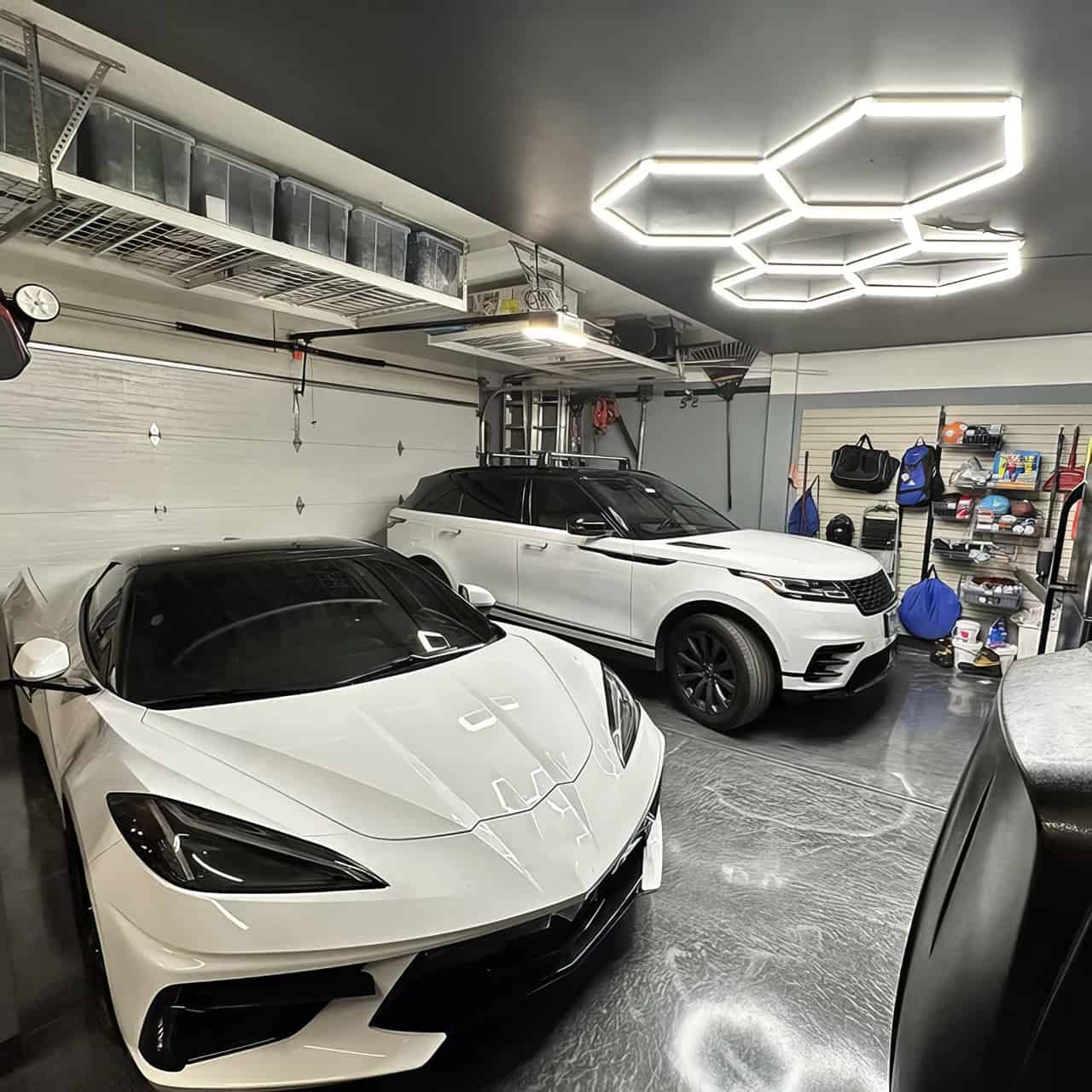As someone who spends countless hours in my garage, I know just how crucial proper lighting is for a functional and inviting space.
In this article, I’ll be your guide as we delve into everything you need to know about garage lighting.
From exploring different types of lights to optimizing your layout, we’ll cover it all.
Get ready to transform your garage into a well-lit haven that you’ll never want to leave.
Let’s shed some light on the subject!
Key Takeaways
Fluorescent or LED lighting is recommended for their efficiency and longer lifespan. I personally prefer hexagon LED lights for their aesthetics.
Different types of garage lights include shop lights, recessed lights, flush mount lights, and rope lights.
Map out workspaces, displays, and storage to assign different layers of task and accent lighting.
Consider using light-colored walls, mirrors, and reflective surfaces to enhance the lighting in your garage.
Table of Contents
Understanding Different Types of Garage Lights
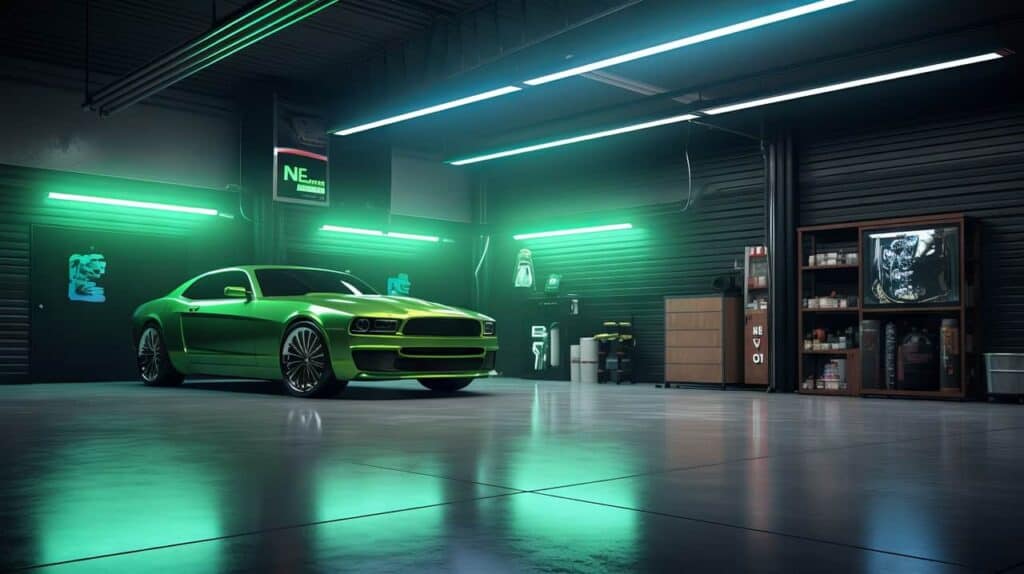
When it comes to garage lighting, it’s important to understand the different types available.
Fluorescent and LED lighting are recommended for their efficiency and longer lifespan.
Shop lights are popular due to their simplicity and cost-effectiveness, while recessed lights provide a bright and fashionable option.
Additionally, rope lights can be used for accenting, and flush mount lights offer a more decorative choice.
Fluorescent Vs. LED Lighting
LED lighting is a more energy-efficient and long-lasting option compared to fluorescent lighting when considering the best type of lighting for your garage. Here are three reasons why LED lighting is a superior choice:
- Energy Efficiency: LED lights use significantly less energy than fluorescent lights, resulting in lower electricity bills and a reduced carbon footprint. With LED technology, you can enjoy bright and vibrant lighting while saving on energy costs.
- Long Lifespan: LED lights have a much longer lifespan compared to fluorescent lights. On average, LED lights can last up to 50,000 hours, whereas fluorescent lights typically last around 10,000 hours. This means less frequent bulb replacements and fewer maintenance hassles.
- Durability: LED lights are more durable and resistant to shock and vibrations compared to fluorescent lights. This makes them ideal for garage environments where there may be heavy machinery or potential impact. LED lights can withstand the rigors of a garage and provide reliable lighting for years to come.
When it comes to garage lighting, LED lighting is the clear winner in terms of energy efficiency, longevity, and durability. Make the switch to LED lights and enjoy a well-lit and efficient garage space.
Advantages of Shop Lights
I prefer using shop lights in my garage due to their simplicity and cost-effectiveness, as well as their options for fluorescent or LED tubes. Shop lights are a popular choice among garage owners for their practicality and versatility. They provide ample illumination for workspace and storage areas while being easy to install and maintain. Additionally, shop lights come in different sizes and designs to fit various garage layouts.
Here is a comparison table highlighting the advantages of shop lights:
| Advantages of Shop Lights |
|---|
| Simplicity |
| Cost-effectiveness |
| Options for fluorescent |
| or LED tubes |
| Versatility |
Shop lights are a cost-effective lighting solution that offers both fluorescent and LED options. Fluorescent tubes are known for their energy efficiency and long lifespan, while LED tubes provide even greater energy savings and durability. With the simplicity and flexibility of shop lights, they are an excellent choice for any garage lighting needs.
Recessed Lights: Pros & Cons
One of the pros of recessed lights is their ability to provide a sleek and modern lighting option for my garage while also saving space and offering a versatile lighting solution.
Here are three key advantages of recessed lights in my garage:
- Space-saving: Recessed lights are inserted into the ceiling, allowing them to blend seamlessly into the space without taking up any valuable real estate. This is especially beneficial in a garage where space is often limited.
- Versatility: Recessed lights can be positioned strategically to provide focused task lighting or to create ambient lighting throughout the entire garage. Their adjustable nature allows for customization based on specific needs and preferences.
- Aesthetic appeal: With their clean and minimalist design, recessed lights add a touch of sophistication to my garage. They create a sleek and modern look that enhances the overall ambiance and style of the space.
Rope Lights for Accenting
I’ve been considering using rope lights for accenting in my garage, so I’m interested in learning more about the different types of garage lights available.
Rope lights can be a great choice for adding a decorative touch to your garage. They’re flexible, easy to install, and can be used for accent or task lighting.
Rope lights are particularly useful for illuminating dark corners, under shelving, or inside cabinets. They come in various colors and can create a warm and inviting atmosphere in your garage.
However, it’s important to note that rope lights may not provide the same level of brightness as other types of garage lights. Therefore, it’s recommended to combine them with other lighting options to ensure proper visibility and functionality in your garage.
Decorative: Flush Mount Lights
To enhance the aesthetic appeal of my garage, I decided to incorporate flush mount lights, which provide both functionality and a decorative touch.
Here’s what you need to know about flush mount lights:
- Versatile Lighting Option: Flush mount lights are dome-shaped lights that hang from the ceiling, offering a stylish lighting choice for any garage. They come in various designs to complement different decorating styles.
- Space-Saving Design: Flush mount lights are ideal for garages with low ceilings or limited space. Their compact design ensures they don’t protrude too much, allowing for easy movement and storage.
- Even Lighting Distribution: These lights are strategically positioned to provide uniform illumination throughout the garage, minimizing shadows and dark spots. This ensures optimal visibility for all your tasks and activities.
Incorporating flush mount lights in your garage not only enhances the functionality of the space but also adds a decorative element that can make you feel a sense of belonging in your own garage sanctuary.
How to Optimize Your Garage Lighting
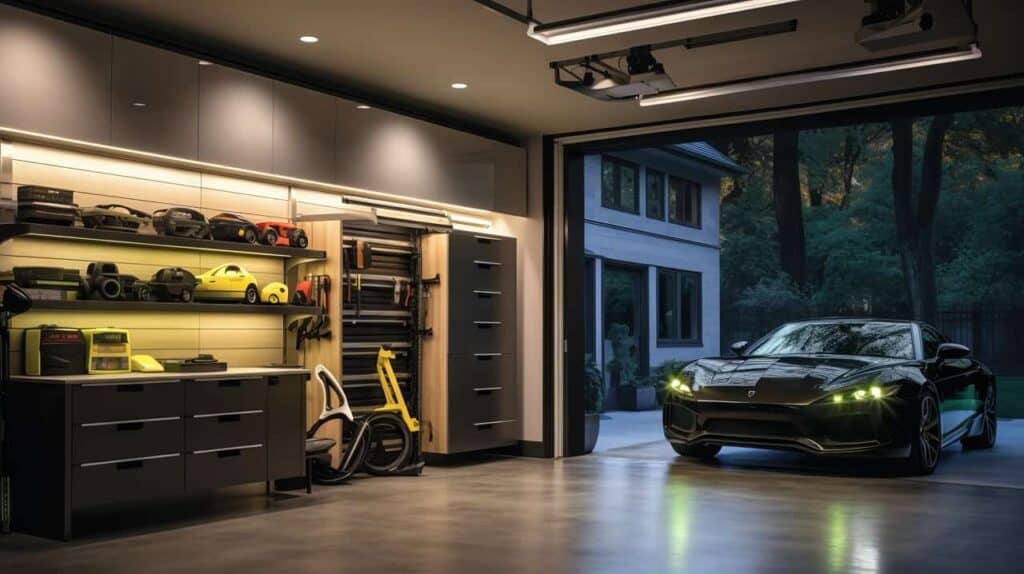
When optimizing your garage lighting, it is important to determine the recommended light output based on the square footage of your garage and the type of lighting needed. To help you understand the different options available, let’s take a look at the table below:
| Type of Lighting | Description |
|---|---|
| Fluorescent or LED lighting | Efficient and long-lasting options, recommended over incandescent lights. |
| Shop lights | Simple and cost-effective, available with fluorescent or LED tubes. |
| Recessed lights | Bright and fashionable lighting option inserted into the ceiling. |
| Flush mount lights | Dome-shaped lights that hang from the ceiling, offering a decorative choice. |
| Rope lights | Used for accent or task lighting, great for under shelving or in dark corners. |
Once you’ve determined the type of lighting you need, it’s essential to map out your workspaces, displays, and storage in order to assign different layers of task and accent lighting. Brighten your highlights more than your general lighting to draw attention, and consider providing brighter task lighting for work areas. Additionally, using light-colored walls or reflective surfaces can enhance your garage lighting. Mirrors or reflective surfaces strategically placed can bounce light around and make the room appear larger. Consider using epoxy floors, as they reflect more usable light compared to mats or rough surfaces.
Considering Alternative Light Sources for Your Garage
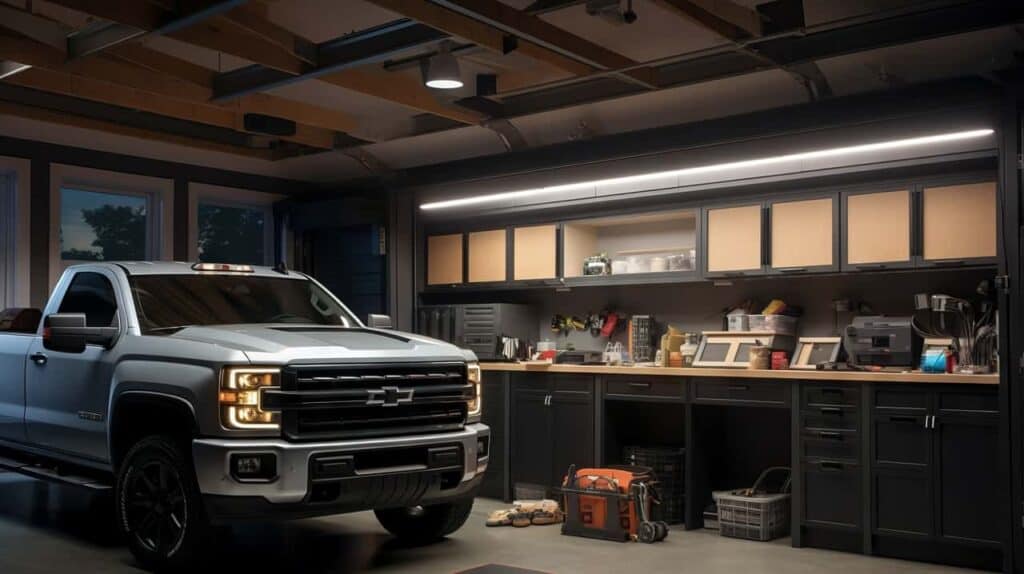
LED lighting is a popular and energy-efficient option for garage lighting, and it can be considered as an alternative light source. When it comes to lighting your garage, it’s important to consider all of your options to create a well-lit and functional space.
Here are three alternative light sources to consider for your garage:
- Natural light: Utilizing windows and skylights can provide a source of natural light, reducing the need for artificial lighting during the day. This not only saves energy but also creates a more pleasant environment.
- Reflective surfaces: Light-colored walls, mirrors, and other reflective surfaces can help bounce light around the garage, making the space appear larger and brighter. Consider using light-colored paint and strategically placing mirrors to maximize the effect.
- High CRI bulbs: The Color Rendering Index (CRI) measures how accurately a light source reveals the true colors of objects. Using high CRI bulbs in your garage lighting can create a more natural and pleasant atmosphere, making it easier to work on projects or find items.
Key Factors to Keep in Mind When Planning Garage Lighting
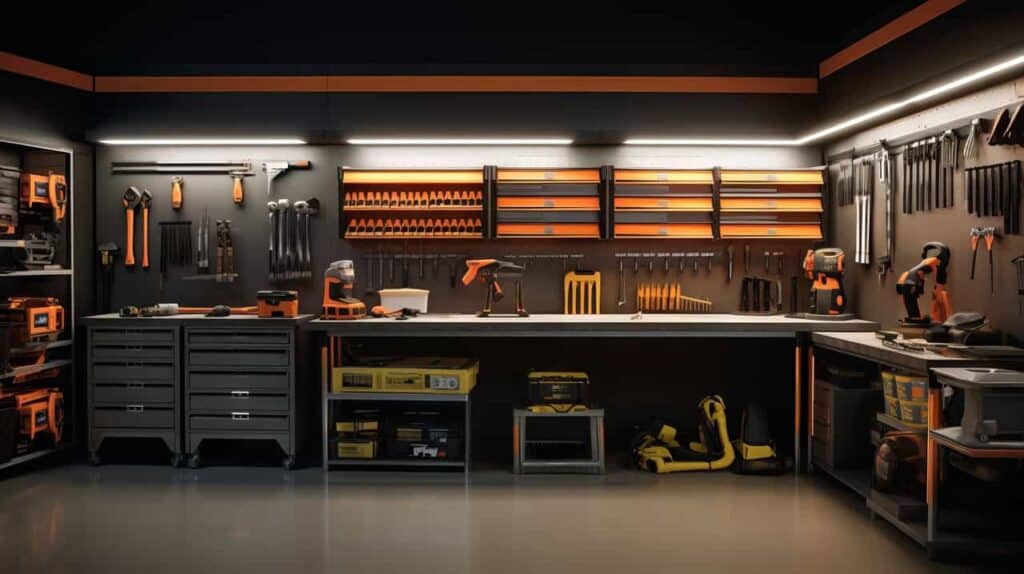
I should consider the key factors in mind for planning garage lighting, such as the recommended light output and the placement of lights. When it comes to garage lighting, it is important to optimize the layout based on your specific needs and goals. To help guide you in this process, I have prepared a table below outlining the key factors to keep in mind:
| Factors to Consider | Importance | Benefits |
|---|---|---|
| Recommended Light Output | Crucial | Provides adequate illumination for tasks and enhances visibility |
| Placement of Lights | Essential | Ensures proper coverage and visibility throughout the garage |
| Energy Efficiency | Important | Reduces power consumption and increases longevity of lights |
| Lighting Accessories | Helpful | Enhances functionality and disperses light in multiple directions |
| Additional Lighting Options | Consideration | Allows for customization and enhanced security |
| Professional Lighting | Valuable | Ensures a well-designed and functional environment |
| Light-colored Walls | Consideration | Reflects more light, reducing the need for additional lighting |
| Reflective Surfaces | Consideration | Bounces light around and makes the room appear larger |
| Flooring Type | Consideration | Epoxy floors reflect more usable light compared to mats or rough surfaces |
The Role of Professional Assistance in Garage Lighting
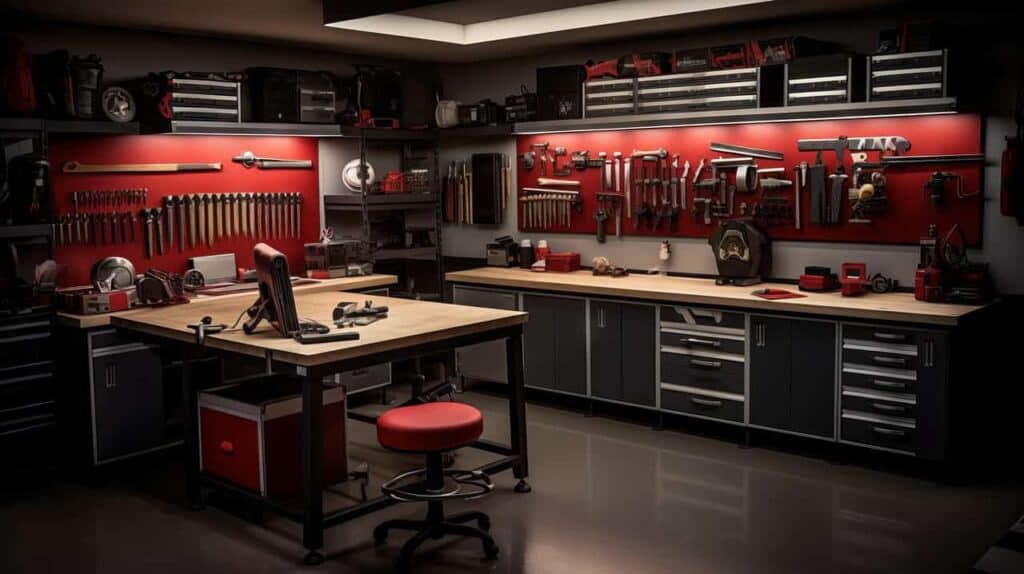
While professional assistance is often overlooked, it plays a crucial role in ensuring a well-designed and functional garage lighting system. Here are three reasons why seeking professional help is essential:
- Expertise: Professionals have extensive knowledge and experience in garage lighting design. They understand the technical aspects, such as light output requirements, placement, and wiring considerations. Their expertise ensures that your garage lighting is optimized for functionality and aesthetics.
- Customization: Professional designers can tailor the lighting layout to suit your specific needs and goals. They’ll assess your garage space, taking into account factors like work areas, storage, and displays. By customizing the lighting design, they can create a well-lit environment that enhances organization and usability.
- Fine-tuning: Experienced designers pay attention to every detail, fine-tuning the lighting layout to perfection. They consider factors like light color, temperature, and distribution to create an inviting and practical space. With their professional touch, your garage lighting system will be optimized for maximum efficiency and visual appeal.
Frequently Asked Questions
What Are the Pros and Cons of Using Recessed Lights in the Garage?
Recessed lights are a popular choice for garage lighting. They provide a bright and fashionable option, but installation can be challenging. Consider the pros and cons based on your specific needs and goals for your garage.
Can I Use Rope Lights as the Primary Source of Lighting in My Garage?
Yes, rope lights can be used as a primary source of lighting in a garage. They are great for accent or task lighting, especially under shelving or in dark corners and cabinets.
Are There Any Specific Lighting Requirements for a Garage Used as a Workshop?
There are specific lighting requirements for a garage used as a workshop. It is important to have sufficient task lighting, bright highlights, and proper coverage to ensure visibility and productivity in the workspace.
How Can I Calculate the Ideal Number of Lumens Needed for My Garage Based on Its Square Footage?
To calculate the ideal number of lumens needed for your garage based on its square footage, divide the square footage by the recommended lumens per square foot. This will give you the approximate number of lumens required for proper lighting.
What Are the Benefits of Using Motion Sensor Lights in the Garage?
Motion sensor lights in the garage offer added convenience and security. They detect movement and automatically turn on, illuminating the space when needed. This feature helps to save energy and provides a hands-free lighting solution.
Conclusion
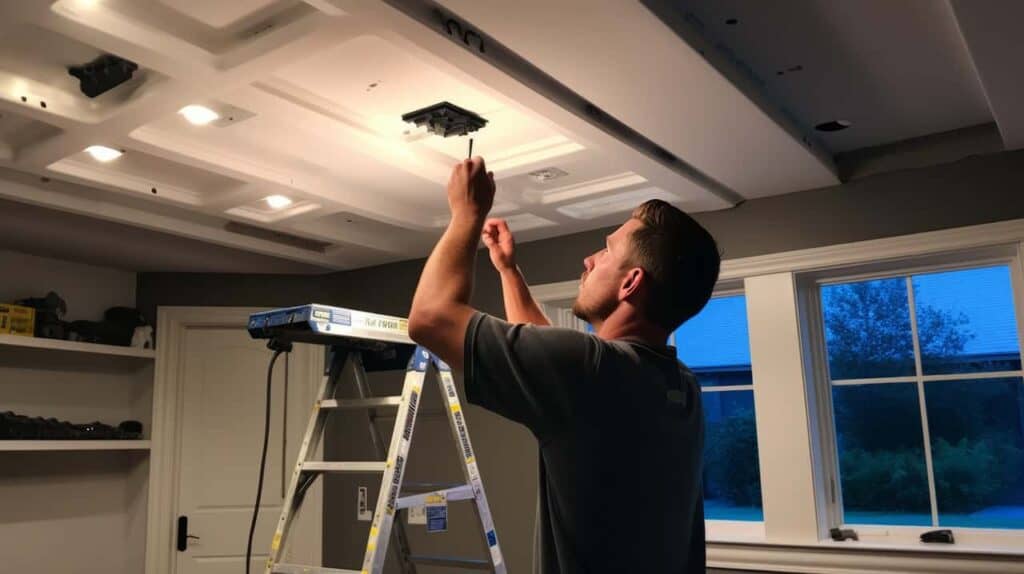
In conclusion, garage lighting isn’t just about practicality but also about creating a welcoming and functional space.
By understanding the different types of lights available and optimizing your lighting layout, you can transform your garage into a well-lit environment that meets your specific needs.
Consider energy-efficient options like LED lighting, and don’t hesitate to seek professional assistance to ensure the best results.
With the right lighting, your garage can become a symbol of productivity and inspiration.
